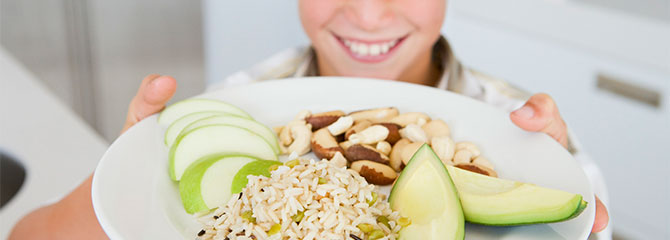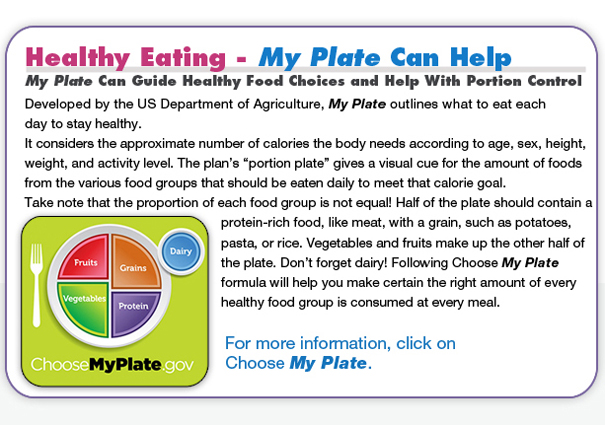Healthy Eating

Eating healthy and exercising are very important for individuals with bleeding disorders. Excess weight puts additional strain on joints. A poor diet can leave children and teens short on protein, vitamins, minerals, and fiber at a time when their growing bodies need these and other important nutrients, such as calcium and iron. Following nutrition and exercise guidelines during childhood can establish healthy eating and physical activity habits that will continue into adulthood.
Healthy Eating and Healthy Body Weight
Eating right and exercising can be hard. By providing a basic understanding of nutrition, as well as stressing the importance of keeping active, parents can lay the foundation for their children to make good decisions about diet and exercise as they grow and become more independent. So remember, parents: lead the way — eat right and exercise!
This section of Next Step will cover:
- Good Nutrition and Maintaining a Healthy Weight
- Healthy Eating
- The Importance of Iron and Calcium During Puberty
- Dietary Supplements
Good Nutrition and Maintaining a Healthy Weight
Eating healthy foods will help keep your child strong and energized. Foods loaded with extra fat, added sugar, and empty calories can lead to excess weight gain and deprive your child's body of the nutrients it needs to meet its growing demands. Being overweight is a particular problem for people with bleeding disorders. Excess weight puts added stress on joints and actually increases the number of painful bleeds. Over time, joint damage can lead to osteoarthritis, a form of arthritis in which cartilage, especially in the knees, which is a major target joint for bleeds, is lost. And because body weight determines how much factor a person needs to prevent or treat a bleed, maintaining a healthy weight can decrease the amount of factor your child needs.
Healthy Eating
For 9-15 year-old kids with busy schedules, eating is often on the run. Often this means frequenting fast-food restaurants and grabbing vending machine snacks. Eating also becomes more and more of a social activity as preteens and teens eat outside of your view, such as at a friend's home or a pizza place. The result can be poor food choices. Besides not always providing the nutrients children need, this may lead to an excessive intake of fats, sugar, and calories. It is important to encourage your child to make healthy choices and eat a balanced diet when you're not around.
For nutritious ideas, go to Tips for Healthy Eating.

The Importance of Iron and Calcium During Puberty
During puberty, adolescents undergo dramatic physical growth and development, which increases their body's requirements for energy, protein, and many vitamins and minerals. Their bones are getting longer as they get taller, and the muscles are growing to support those big bones.
Two important nutrients adolescents should include in their diets are calcium and iron.
- Calcium. Bones grow rapidly during adolescence. Children aged 9 to 15 years need calcium to build strong bones, prevent tooth decay, and fight loss of bone density later in life. But many don't get the recommended daily amount of calcium.
Preteens and teens need 3 cups of low-fat or fat-free milk every day, plus other calcium-rich foods. Calcium-rich foods include low-fat cheese and low-fat yogurt; and dairy-free foods, such as calcium-fortified juice and cereals; beans; and dark green, leafy vegetables (for example spinach, broccoli, and bok choy).
Be mindful that certain foods and beverages, including sodas and caffeinated drinks, can interfere with the way the body absorbs and uses calcium.
- Iron. Iron builds up blood cells, which may be especially helpful after a bleed or injury. Iron also helps blood carry oxygen to the body's muscles. During a bleed, a small amount of iron is lost. Your child can maintain adequate iron levels by eating naturally iron-rich foods such as liver, lean red meat, and poultry. Other sources of iron include leafy green vegetables, broccoli, dried beans, grains, and raisins. Combining iron-rich foods with good sources of vitamin C (such as orange juice) can help the body absorb iron. Certain foods can also block iron absorption; these include coffee, tea, egg yolks, milk, fiber, and soy protein. It's best to avoid eating these and iron-rich foods at the same time. From puberty through the childbearing years, females need more iron than males because women lose iron with each menstrual period. Teenage girls and women who have heavy periods are at risk of losing too much iron and developing iron-deficiency anemia. Heavy menstrual bleeding (called menorrhagia) is the most common cause of anemia in women.
Here are some common signs of anemia:
- Tiredness
- Weakness
- Tingling and numbness in fingers or toes
- Sensitivity to cold
- Talk to your Hemophilia Treatment Center (HTC) about ways to fight iron loss and include iron-rich foods or supplements in your daughter's diet.
Dietary Supplements
Many people use dietary supplements and herbal remedies to prevent specific ailments or to complement more traditional medical treatments. However, some of these can be harmful for people with bleeding disorders because they may interfere with clotting or cause prolonged bleeding.
Here are a few with potential harmful side effects:
- Bilberry
- Ginkgo biloba
- Bromelain
- Horse chestnut
